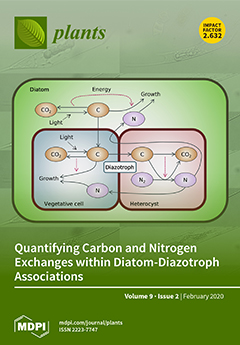Alpinia katsumadai (
A. katsumadai),
Alpinia oxyphylla (
A. oxyphylla) and
Alpinia pumila (
A. pumila), which belong to the family Zingiberaceae, exhibit multiple medicinal properties. The chloroplast genome of a non-model plant provides valuable information for species identification and phylogenetic analysis. Here, we sequenced three complete chloroplast genomes of
A. katsumadai,
A. oxyphylla sampled from Guangdong and
A. pumila, and analyzed the published chloroplast genomes of
Alpinia zerumbet (
A. zerumbet) and
A. oxyphylla sampled from Hainan to retrieve useful chloroplast molecular resources for
Alpinia. The five
Alpinia chloroplast genomes possessed typical quadripartite structures comprising of a large single copy (LSC, 87,248–87,667 bp), a small single copy (SSC, 15,306–18,295 bp) and a pair of inverted repeats (IR, 26,917–29,707 bp). They had similar gene contents, gene orders and GC contents, but were slightly different in the numbers of small sequence repeats (SSRs) and long repeats. Interestingly, fifteen highly divergent regions (
rpl36,
ycf1,
rps15,
rpl22,
infA,
psbT-psbN,
accD-psaI,
petD-rpoA,
psaC-ndhE,
ccsA-ndhD,
ndhF-rpl32,
rps11-rpl36,
infA-rps8,
psbC-psbZ, and
rpl32-ccsA), which could be suitable for species identification and phylogenetic studies, were detected in the
Alpinia chloroplast genomes. Comparative analyses among the five chloroplast genomes indicated that 1891 mutational events, including 304 single nucleotide polymorphisms (SNPs) and 118 insertion/deletions (indels) between
A. pumila and
A. katsumadai, 367 SNPs and 122 indels between
A. pumila and
A. oxyphylla sampled from Guangdong, 331 SNPs and 115 indels between
A. pumila and
A. zerumbet, 371 SNPs and 120 indels between
A. pumila and
A. oxyphylla sampled from Hainan, and 20 SNPs and 23 indels between the two accessions of
A. oxyphylla, were accurately located. Additionally, phylogenetic relationships based on SNP matrix among 28 whole chloroplast genomes showed that
Alpinia was a sister branch to
Amomum in the family Zingiberaceae, and that the five
Alpinia accessions were divided into three groups, one including
A. pumila, another including
A. zerumbet and
A. katsumadai, and the other including two accessions of
A. oxyphylla. In conclusion, the complete chloroplast genomes of the three medicinal
Alpinia species in this study provided valuable genomic resources for further phylogeny and species identification in the family Zingiberaceae.
Full article






